2024届高考英语一轮复习:阅读理解当堂练习(说明文)课件 (共20张PPT)
文档属性
| 名称 | 2024届高考英语一轮复习:阅读理解当堂练习(说明文)课件 (共20张PPT) | 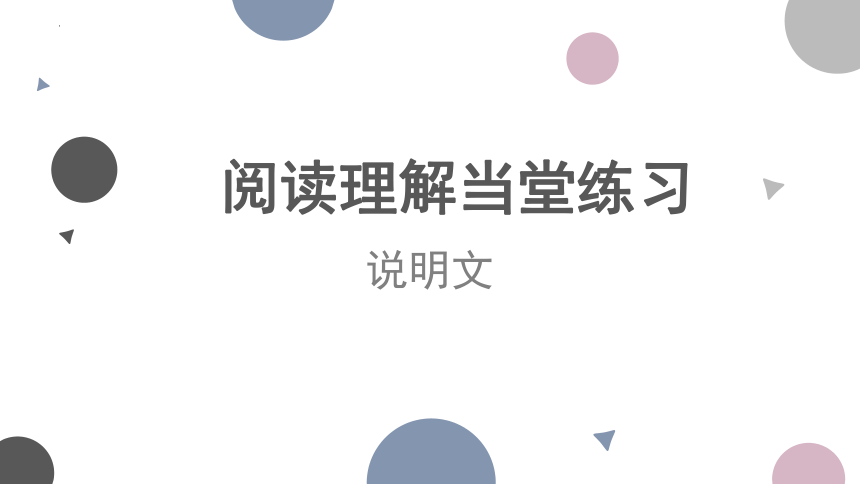 | |
| 格式 | pptx | ||
| 文件大小 | 357.2KB | ||
| 资源类型 | 教案 | ||
| 版本资源 | 通用版 | ||
| 科目 | 英语 | ||
| 更新时间 | 2024-02-08 09:53:27 | ||
图片预览


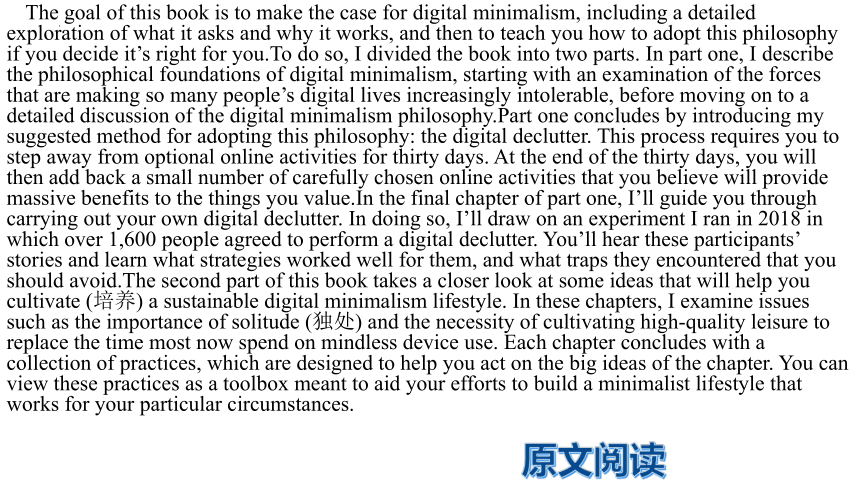
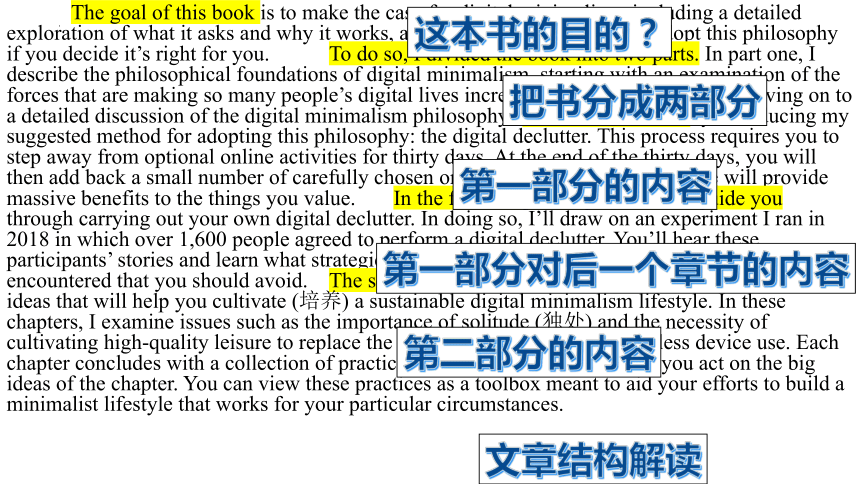

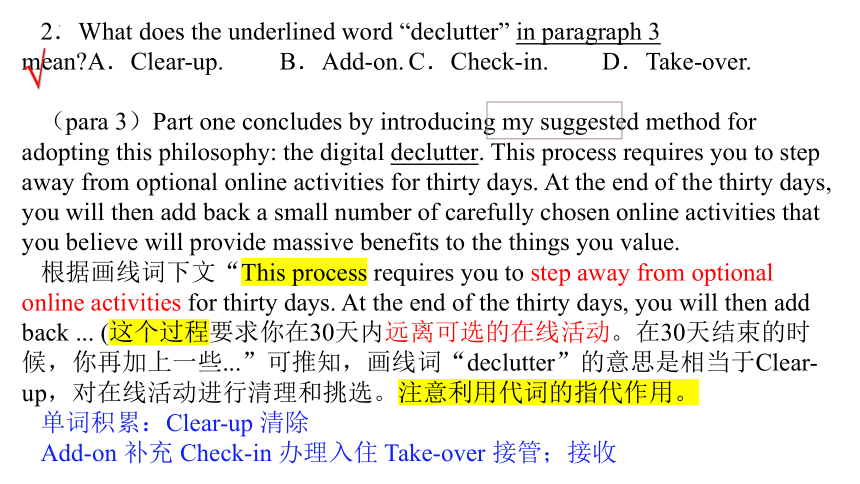
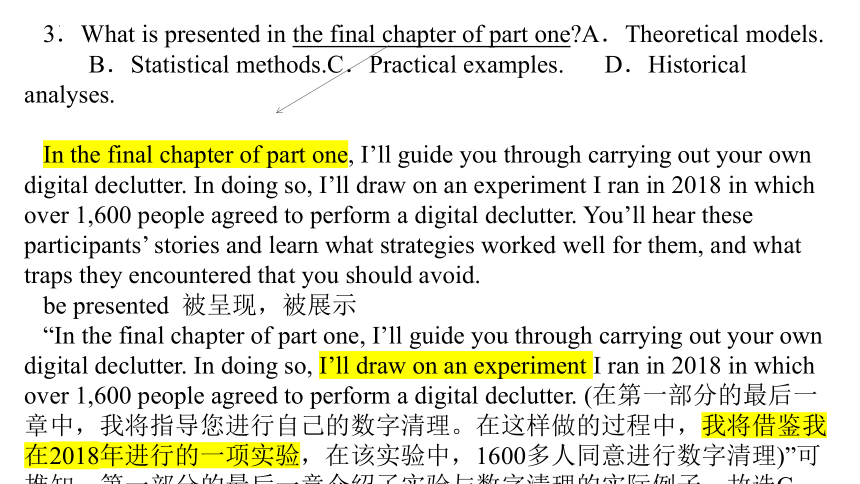

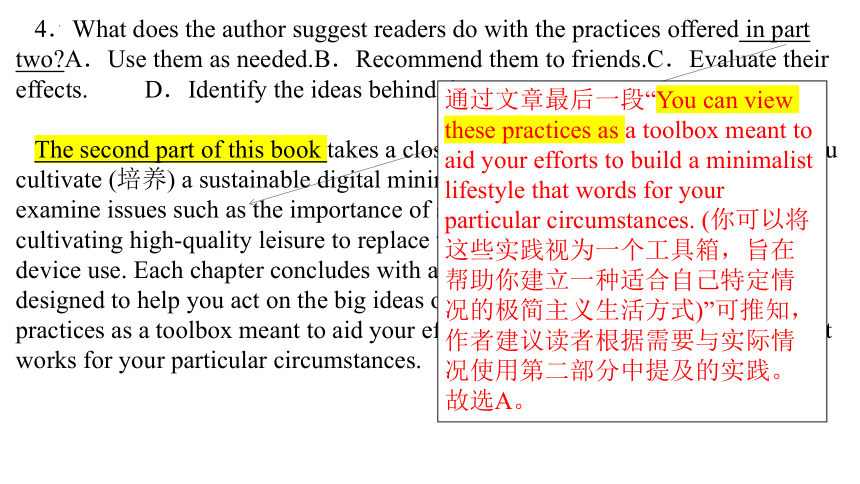
文档简介
(共20张PPT)
阅读理解当堂练习
说明文
说明文类阅读策略
掌握文章整体结构和细节信息,是可以在有限的时间内达到基本理解的。在分析文章整体结构时,可采用以下几种阅读策略。
通过文章第一段迅速找出说明文介绍或阐述的事物
关注每一段的段首句,确认段落的主旨大意
关注每一段的段尾句
通过段首句和段尾句确定段落之间的逻辑关系
注意:积累词汇
The goal of this book is to make the case for digital minimalism, including a detailed exploration of what it asks and why it works, and then to teach you how to adopt this philosophy if you decide it’s right for you.To do so, I divided the book into two parts. In part one, I describe the philosophical foundations of digital minimalism, starting with an examination of the forces that are making so many people’s digital lives increasingly intolerable, before moving on to a detailed discussion of the digital minimalism philosophy.Part one concludes by introducing my suggested method for adopting this philosophy: the digital declutter. This process requires you to step away from optional online activities for thirty days. At the end of the thirty days, you will then add back a small number of carefully chosen online activities that you believe will provide massive benefits to the things you value.In the final chapter of part one, I’ll guide you through carrying out your own digital declutter. In doing so, I’ll draw on an experiment I ran in 2018 in which over 1,600 people agreed to perform a digital declutter. You’ll hear these participants’ stories and learn what strategies worked well for them, and what traps they encountered that you should avoid.The second part of this book takes a closer look at some ideas that will help you cultivate (培养) a sustainable digital minimalism lifestyle. In these chapters, I examine issues such as the importance of solitude (独处) and the necessity of cultivating high-quality leisure to replace the time most now spend on mindless device use. Each chapter concludes with a collection of practices, which are designed to help you act on the big ideas of the chapter. You can view these practices as a toolbox meant to aid your efforts to build a minimalist lifestyle that works for your particular circumstances.
原文阅读
The goal of this book is to make the case for digital minimalism, including a detailed exploration of what it asks and why it works, and then to teach you how to adopt this philosophy if you decide it’s right for you. To do so, I divided the book into two parts. In part one, I describe the philosophical foundations of digital minimalism, starting with an examination of the forces that are making so many people’s digital lives increasingly intolerable, before moving on to a detailed discussion of the digital minimalism philosophy. Part one concludes by introducing my suggested method for adopting this philosophy: the digital declutter. This process requires you to step away from optional online activities for thirty days. At the end of the thirty days, you will then add back a small number of carefully chosen online activities that you believe will provide massive benefits to the things you value. In the final chapter of part one, I’ll guide you through carrying out your own digital declutter. In doing so, I’ll draw on an experiment I ran in 2018 in which over 1,600 people agreed to perform a digital declutter. You’ll hear these participants’ stories and learn what strategies worked well for them, and what traps they encountered that you should avoid. The second part of this book takes a closer look at some ideas that will help you cultivate (培养) a sustainable digital minimalism lifestyle. In these chapters, I examine issues such as the importance of solitude (独处) and the necessity of cultivating high-quality leisure to replace the time most now spend on mindless device use. Each chapter concludes with a collection of practices, which are designed to help you act on the big ideas of the chapter. You can view these practices as a toolbox meant to aid your efforts to build a minimalist lifestyle that works for your particular circumstances.
把书分成两部分
这本书的目的?
第一部分的内容
第一部分对后一个章节的内容
第二部分的内容
文章结构解读
1.What is the book aimed at A.Teaching critical thinking skills. B.Advocating a simple digital lifestyle.C.Solving philosophical problems. D.Promoting the use of a digital device.
be aimed at 目的是,旨在
The goal of this book is to make the case for digital minimalism, including a detailed exploration of what it asks and why it works, and then to teach you how to adopt this philosophy if you decide it’s right for you.
由此得出正确答案为B.
单词积累:minimalism n. 极简派艺术;最低纲领;极保守行动
→minimalistic 极简化的=simple
minimalist n. 极简抽象派艺术家
advocate v. 拥护,提倡
promote v. 促进,提倡;升职,
philosophy n. 哲学;哲学体系,思想体系
philosophical adj. 哲学的;达观的,
2.What does the underlined word “declutter” in paragraph 3 mean A.Clear-up. B.Add-on. C.Check-in. D.Take-over.
(para 3)Part one concludes by introducing my suggested method for adopting this philosophy: the digital declutter. This process requires you to step away from optional online activities for thirty days. At the end of the thirty days, you will then add back a small number of carefully chosen online activities that you believe will provide massive benefits to the things you value.
根据画线词下文“This process requires you to step away from optional online activities for thirty days. At the end of the thirty days, you will then add back ... (这个过程要求你在30天内远离可选的在线活动。在30天结束的时候,你再加上一些...”可推知,画线词“declutter”的意思是相当于Clear-up,对在线活动进行清理和挑选。注意利用代词的指代作用。
单词积累:Clear-up 清除
Add-on 补充 Check-in 办理入住 Take-over 接管;接收
√
3.What is presented in the final chapter of part one A.Theoretical models. B.Statistical methods.C.Practical examples. D.Historical analyses.
In the final chapter of part one, I’ll guide you through carrying out your own digital declutter. In doing so, I’ll draw on an experiment I ran in 2018 in which over 1,600 people agreed to perform a digital declutter. You’ll hear these participants’ stories and learn what strategies worked well for them, and what traps they encountered that you should avoid.
be presented 被呈现,被展示
“In the final chapter of part one, I’ll guide you through carrying out your own digital declutter. In doing so, I’ll draw on an experiment I ran in 2018 in which over 1,600 people agreed to perform a digital declutter. (在第一部分的最后一章中,我将指导您进行自己的数字清理。在这样做的过程中,我将借鉴我在2018年进行的一项实验,在该实验中,1600多人同意进行数字清理)”可推知,第一部分的最后一章介绍了实验与数字清理的实际例子。故选C。
3.What is presented in the final chapter of part one A.Theoretical models. B.Statistical methods.C.Practical examples. D.Historical analyses.
In the final chapter of part one, I’ll guide you through carrying out your own digital declutter. In doing so, I’ll draw on an experiment I ran in 2018 in which over 1,600 people agreed to perform a digital declutter. You’ll hear these participants’ stories and learn what strategies worked well for them, and what traps they encountered that you should avoid.
词汇积累:be presented 被呈现,被展示
Theoretical models 理论模型
Statistical methods 统计方法
Practical examples 实际例子
Historical analyses 历史分析
4.What does the author suggest readers do with the practices offered in part two A.Use them as needed.B.Recommend them to friends.C.Evaluate their effects. D.Identify the ideas behind them.
The second part of this book takes a closer look at some ideas that will help you cultivate (培养) a sustainable digital minimalism lifestyle. In these chapters, I examine issues such as the importance of solitude (独处) and the necessity of cultivating high-quality leisure to replace the time most now spend on mindless device use. Each chapter concludes with a collection of practices, which are designed to help you act on the big ideas of the chapter. You can view these practices as a toolbox meant to aid your efforts to build a minimalist lifestyle that works for your particular circumstances.
通过文章最后一段“You can view these practices as a toolbox meant to aid your efforts to build a minimalist lifestyle that words for your particular circumstances. (你可以将这些实践视为一个工具箱,旨在帮助你建立一种适合自己特定情况的极简主义生活方式)”可推知,作者建议读者根据需要与实际情况使用第二部分中提及的实践。故选A。
4.What does the author suggest readers do with the practices offered in part two
A.Use them as needed. B.Recommend them to friends. C.Evaluate their effects. D.Identify the ideas behind them.
单词积累:
Recommend v. 建议,劝告 ;推荐,介绍
Evaluate v. 评价,评估,估值;
Identify v. 认出,识别;查明,确认
view... as 视为
Reading Art: Art for Book Lovers is a celebration of an everyday object — the book, represented here in almost three hundred artworks from museums around the world. The image of the reader appears throughout history, in art made long before books as we now know them came into being. In artists’ representations of books and reading, we see moments of shared humanity that go beyond culture and time. In this “book of books,” artworks are selected and arranged in a way that emphasizes these connections between different eras and cultures. We see scenes of children learning to read at home or at school, with the book as a focus for relations between the generations. Adults are portrayed (描绘) alone in many settings and poses —absorbed in a volume, deep in thought or lost in a moment of leisure. These scenes may have been painted hundreds of years ago, but they record moments we can all relate to. Books themselves may be used symbolically in paintings to demonstrate the intellect (才智), wealth or faith of the subject. Before the wide use of the printing press, books were treasured objects and could be works of art in their own right. More recently, as books have become inexpensive or even throwaway, artists have used them as the raw material for artworks — transforming covers, pages or even complete volumes into paintings and sculptures. Continued developments in communication technologies were once believed to make the printed page outdated. From a 21st-century point of view, the printed book is certainly ancient, but it remains as interactive as any battery-powered e-reader. To serve its function, a book must be activated by a user: the cover opened, the pages parted, the contents reviewed, perhaps notes written down or words underlined. And in contrast to our increasingly networked lives where the information we consume is monitored and tracked, a printed book still offers the chance of a wholly private, “off-line” activity.
原文阅读
Reading Art: Art for Book Lovers is a celebration of an everyday object — the book, represented here in almost three hundred artworks from museums around the world. The image of the reader appears throughout history, in art made long before books as we now know them came into being. In artists’ representations of books and reading, we see moments of shared humanity that go beyond culture and time. In this “book of books,” artworks are selected and arranged in a way that emphasizes these connections between different eras and cultures. We see scenes of children learning to read at home or at school, with the book as a focus for relations between the generations. Adults are portrayed (描绘) alone in many settings and poses —absorbed in a volume, deep in thought or lost in a moment of leisure. These scenes may have been painted hundreds of years ago, but they record moments we can all relate to. Books themselves may be used symbolically in paintings to demonstrate the intellect (才智), wealth or faith of the subject. Before the wide use of the printing press, books were treasured objects and could be works of art in their own right. More recently, as books have become inexpensive or even throwaway, artists have used them as the raw material for artworks — transforming covers, pages or even complete volumes into paintings and sculptures. Continued developments in communication technologies were once believed to make the printed page outdated. From a 21st-century point of view, the printed book is certainly ancient, but it remains as interactive as any battery-powered e-reader. To serve its function, a book must be activated by a user: the cover opened, the pages parted, the contents reviewed, perhaps notes written down or words underlined. And in contrast to our increasingly networked lives where the information we consume is monitored and tracked, a printed book still offers the chance of a wholly private, “off-line” activity.
文章结构解读
书的艺术
艺术在书中的体现
书和艺术的关系
印刷书的意义
5.Where is the text most probably taken from A.An introduction to a book. B.An essay on the art of writing.C.A guidebook to a museum. D.A review of modern paintings.
Where is the text most probably taken from 这段文字最有可能取自哪里
由此得知,此题考查文章出处。文章第二段段头,In this “book of books,” artworks are selected and arranged in a way that emphasizes these connections between different eras and cultures....以及第三段“Books themselves may be used symbolically in paintings to demonstrate the intellect, wealth or faith of the subject. 和最后一段“From a 21st-century point of view, the printed book is certainly ancient, but it remains as interactive as any battery-powered e-reader.可推知,本文最有可能出自一本印刷书的扉页,即对该书的介绍。故选A。
积累单词:introduction n. 初次投入使用,采用;介绍,引见
essay n. 短文,论说文; (用来刊登的)散文,随笔;
guidebook n. 旅行指南;指南,手册
review n. 审查,检查;评论,评论文章
6.What are the selected artworks about A.Wealth and intellect. B.Home and school.C.Books and reading. D.Work and leisure.
In this “book of books,” artworks are selected and arranged in a way that emphasizes these connections between different eras and cultures. We see scenes of children learning to read at home or at school, with the book as a focus for relations between the generations. Adults are portrayed (描绘) alone in many settings and poses —absorbed in a volume, deep in thought or lost in a moment of leisure. These scenes may have been painted hundreds of years ago, but they record moments we can all relate to.
“artworks are selected and arranged in a way that emphasizes these connections between different eras and cultures. We see scenes of children learning to read at home or at school, with the book as a focus for relations between the generations. (艺术品的选择和排列方式强调了不同时代和文化之间的联系。我们看到孩子们在家里或学校学习阅读的场景,这本书是几代人之间关系的焦点)”可知,选定的艺术品是关于书籍和阅读的。故选C。
6.What are the selected artworks about A.Wealth and intellect. B.Home and school.C.Books and reading. D.Work and leisure.
In this “book of books,” artworks are selected and arranged in a way that emphasizes these connections between different eras and cultures. We see scenes of children learning to read at home or at school, with the book as a focus for relations between the generations. Adults are portrayed (描绘) alone in many settings and poses —absorbed in a volume, deep in thought or lost in a moment of leisure. These scenes may have been painted hundreds of years ago, but they record moments we can all relate to.
单词积累:Wealth and intellect 财富和智慧
intellect n. 智力,思维能力
intellectual adj. 智力的,理智的;才智超群的
intelligent adj. 聪明的;有智力的;智能的
leisure n. 闲暇,业余时间;休闲活动adj. 空闲的,有闲的;业余的
7.What do the underlined words “relate to” in paragraph 2 mean A.Understand. B.Paint. C.Seize. D.Transform.
In this “book of books,” artworks are selected and arranged in a way that emphasizes these connections between different eras and cultures. We see scenes of children learning to read at home or at school, with the book as a focus for relations between the generations. Adults are portrayed (描绘) alone in many settings and poses —absorbed in a volume, deep in thought or lost in a moment of leisure. These scenes may have been painted hundreds of years ago, but they record moments we can all relate to.
根据画线词上文“artworks are selected and arranged in a way that emphasizes these connections between different eras and cultures. We see scenes of children learning to read at home or at school, with the book as a focus for relations between the generations. (艺术品的选择和排列方式强调了不同时代和文化之间的联系。我们看到孩子们在家里或学校学习阅读的场景,这本书是几代人之间关系的焦点)”以及“These scenes may have been painted hundreds of years ago, but they record moments (这些场景可能是数百年前绘制的,但它们记录了一些时刻)”可推知,此处指书籍是人类之间相互联系和理解的纽带,故与画线短语“relate to”意思最相近的为A项“理解、认识到”。故选A。
7.What do the underlined words “relate to” in paragraph 2 mean A.Understand. B.Paint. C.Seize. D.Transform.
In this “book of books,” artworks are selected and arranged in a way that emphasizes these connections between different eras and cultures. We see scenes of children learning to read at home or at school, with the book as a focus for relations between the generations. Adults are portrayed (描绘) alone in many settings and poses —absorbed in a volume, deep in thought or lost in a moment of leisure. These scenes may have been painted hundreds of years ago, but they record moments we can all relate to.
单词积累:relate to 与……有关;理解并与……产生共鸣=understand
Seize v. 抓住,捉住;(用武力)夺取,占领;逮捕,捉拿
Transform v. 使改观,使变形,使转化;
transformable adj. 可变化的;可变形的;可转化的
transformation n. (彻底或重大的)改观,变化,转变
8.What does the author want to say by mentioning the e-reader A.The printed book is not totally out of date.B.Technology has changed the way we read.C.Our lives in the 21st century are networked.D.People now rarely have the patience to read.
Continued developments in communication technologies were once believed to make the printed page outdated. From a 21st-century point of view, the printed book is certainly ancient, but it remains as interactive as any battery-powered e-reader. To serve its function, a book must be activated by a user: the cover opened, the pages parted, the contents reviewed, perhaps notes written down or words underlined. And in contrast to our increasingly networked lives where the information we consume is monitored and tracked, a printed book still offers the chance of a wholly private, “off-line” activity.
“it remains as interactive as any battery-powered e-reader (它仍然像任何电池供电的电子阅读器一样具有互动性)”以及“printed book still offers the chance of a wholly private, “off-line” activity (印刷书籍仍然提供了完全私人的“离线”活动的机会)”可推知,本文作者提到电子阅读器想表达的是印刷书籍并没有完全过时。故选A。
8.What does the author want to say by mentioning the e-reader A.The printed book is not totally out of date.B.Technology has changed the way we read.C.Our lives in the 21st century are networked.D.People now rarely have the patience to read.
积累单词:out of date 过时的
Technology n. 科技,技术;技术设备
rarely adv. 罕有,很少;异乎寻常地
patience n. 耐心;耐性;忍耐力;
patient adj. 能忍耐的,有耐心的
battery-powered adj. [电] 靠电池供电的
Practice Makes Perfect
阅读理解当堂练习
说明文
说明文类阅读策略
掌握文章整体结构和细节信息,是可以在有限的时间内达到基本理解的。在分析文章整体结构时,可采用以下几种阅读策略。
通过文章第一段迅速找出说明文介绍或阐述的事物
关注每一段的段首句,确认段落的主旨大意
关注每一段的段尾句
通过段首句和段尾句确定段落之间的逻辑关系
注意:积累词汇
The goal of this book is to make the case for digital minimalism, including a detailed exploration of what it asks and why it works, and then to teach you how to adopt this philosophy if you decide it’s right for you.To do so, I divided the book into two parts. In part one, I describe the philosophical foundations of digital minimalism, starting with an examination of the forces that are making so many people’s digital lives increasingly intolerable, before moving on to a detailed discussion of the digital minimalism philosophy.Part one concludes by introducing my suggested method for adopting this philosophy: the digital declutter. This process requires you to step away from optional online activities for thirty days. At the end of the thirty days, you will then add back a small number of carefully chosen online activities that you believe will provide massive benefits to the things you value.In the final chapter of part one, I’ll guide you through carrying out your own digital declutter. In doing so, I’ll draw on an experiment I ran in 2018 in which over 1,600 people agreed to perform a digital declutter. You’ll hear these participants’ stories and learn what strategies worked well for them, and what traps they encountered that you should avoid.The second part of this book takes a closer look at some ideas that will help you cultivate (培养) a sustainable digital minimalism lifestyle. In these chapters, I examine issues such as the importance of solitude (独处) and the necessity of cultivating high-quality leisure to replace the time most now spend on mindless device use. Each chapter concludes with a collection of practices, which are designed to help you act on the big ideas of the chapter. You can view these practices as a toolbox meant to aid your efforts to build a minimalist lifestyle that works for your particular circumstances.
原文阅读
The goal of this book is to make the case for digital minimalism, including a detailed exploration of what it asks and why it works, and then to teach you how to adopt this philosophy if you decide it’s right for you. To do so, I divided the book into two parts. In part one, I describe the philosophical foundations of digital minimalism, starting with an examination of the forces that are making so many people’s digital lives increasingly intolerable, before moving on to a detailed discussion of the digital minimalism philosophy. Part one concludes by introducing my suggested method for adopting this philosophy: the digital declutter. This process requires you to step away from optional online activities for thirty days. At the end of the thirty days, you will then add back a small number of carefully chosen online activities that you believe will provide massive benefits to the things you value. In the final chapter of part one, I’ll guide you through carrying out your own digital declutter. In doing so, I’ll draw on an experiment I ran in 2018 in which over 1,600 people agreed to perform a digital declutter. You’ll hear these participants’ stories and learn what strategies worked well for them, and what traps they encountered that you should avoid. The second part of this book takes a closer look at some ideas that will help you cultivate (培养) a sustainable digital minimalism lifestyle. In these chapters, I examine issues such as the importance of solitude (独处) and the necessity of cultivating high-quality leisure to replace the time most now spend on mindless device use. Each chapter concludes with a collection of practices, which are designed to help you act on the big ideas of the chapter. You can view these practices as a toolbox meant to aid your efforts to build a minimalist lifestyle that works for your particular circumstances.
把书分成两部分
这本书的目的?
第一部分的内容
第一部分对后一个章节的内容
第二部分的内容
文章结构解读
1.What is the book aimed at A.Teaching critical thinking skills. B.Advocating a simple digital lifestyle.C.Solving philosophical problems. D.Promoting the use of a digital device.
be aimed at 目的是,旨在
The goal of this book is to make the case for digital minimalism, including a detailed exploration of what it asks and why it works, and then to teach you how to adopt this philosophy if you decide it’s right for you.
由此得出正确答案为B.
单词积累:minimalism n. 极简派艺术;最低纲领;极保守行动
→minimalistic 极简化的=simple
minimalist n. 极简抽象派艺术家
advocate v. 拥护,提倡
promote v. 促进,提倡;升职,
philosophy n. 哲学;哲学体系,思想体系
philosophical adj. 哲学的;达观的,
2.What does the underlined word “declutter” in paragraph 3 mean A.Clear-up. B.Add-on. C.Check-in. D.Take-over.
(para 3)Part one concludes by introducing my suggested method for adopting this philosophy: the digital declutter. This process requires you to step away from optional online activities for thirty days. At the end of the thirty days, you will then add back a small number of carefully chosen online activities that you believe will provide massive benefits to the things you value.
根据画线词下文“This process requires you to step away from optional online activities for thirty days. At the end of the thirty days, you will then add back ... (这个过程要求你在30天内远离可选的在线活动。在30天结束的时候,你再加上一些...”可推知,画线词“declutter”的意思是相当于Clear-up,对在线活动进行清理和挑选。注意利用代词的指代作用。
单词积累:Clear-up 清除
Add-on 补充 Check-in 办理入住 Take-over 接管;接收
√
3.What is presented in the final chapter of part one A.Theoretical models. B.Statistical methods.C.Practical examples. D.Historical analyses.
In the final chapter of part one, I’ll guide you through carrying out your own digital declutter. In doing so, I’ll draw on an experiment I ran in 2018 in which over 1,600 people agreed to perform a digital declutter. You’ll hear these participants’ stories and learn what strategies worked well for them, and what traps they encountered that you should avoid.
be presented 被呈现,被展示
“In the final chapter of part one, I’ll guide you through carrying out your own digital declutter. In doing so, I’ll draw on an experiment I ran in 2018 in which over 1,600 people agreed to perform a digital declutter. (在第一部分的最后一章中,我将指导您进行自己的数字清理。在这样做的过程中,我将借鉴我在2018年进行的一项实验,在该实验中,1600多人同意进行数字清理)”可推知,第一部分的最后一章介绍了实验与数字清理的实际例子。故选C。
3.What is presented in the final chapter of part one A.Theoretical models. B.Statistical methods.C.Practical examples. D.Historical analyses.
In the final chapter of part one, I’ll guide you through carrying out your own digital declutter. In doing so, I’ll draw on an experiment I ran in 2018 in which over 1,600 people agreed to perform a digital declutter. You’ll hear these participants’ stories and learn what strategies worked well for them, and what traps they encountered that you should avoid.
词汇积累:be presented 被呈现,被展示
Theoretical models 理论模型
Statistical methods 统计方法
Practical examples 实际例子
Historical analyses 历史分析
4.What does the author suggest readers do with the practices offered in part two A.Use them as needed.B.Recommend them to friends.C.Evaluate their effects. D.Identify the ideas behind them.
The second part of this book takes a closer look at some ideas that will help you cultivate (培养) a sustainable digital minimalism lifestyle. In these chapters, I examine issues such as the importance of solitude (独处) and the necessity of cultivating high-quality leisure to replace the time most now spend on mindless device use. Each chapter concludes with a collection of practices, which are designed to help you act on the big ideas of the chapter. You can view these practices as a toolbox meant to aid your efforts to build a minimalist lifestyle that works for your particular circumstances.
通过文章最后一段“You can view these practices as a toolbox meant to aid your efforts to build a minimalist lifestyle that words for your particular circumstances. (你可以将这些实践视为一个工具箱,旨在帮助你建立一种适合自己特定情况的极简主义生活方式)”可推知,作者建议读者根据需要与实际情况使用第二部分中提及的实践。故选A。
4.What does the author suggest readers do with the practices offered in part two
A.Use them as needed. B.Recommend them to friends. C.Evaluate their effects. D.Identify the ideas behind them.
单词积累:
Recommend v. 建议,劝告 ;推荐,介绍
Evaluate v. 评价,评估,估值;
Identify v. 认出,识别;查明,确认
view... as 视为
Reading Art: Art for Book Lovers is a celebration of an everyday object — the book, represented here in almost three hundred artworks from museums around the world. The image of the reader appears throughout history, in art made long before books as we now know them came into being. In artists’ representations of books and reading, we see moments of shared humanity that go beyond culture and time. In this “book of books,” artworks are selected and arranged in a way that emphasizes these connections between different eras and cultures. We see scenes of children learning to read at home or at school, with the book as a focus for relations between the generations. Adults are portrayed (描绘) alone in many settings and poses —absorbed in a volume, deep in thought or lost in a moment of leisure. These scenes may have been painted hundreds of years ago, but they record moments we can all relate to. Books themselves may be used symbolically in paintings to demonstrate the intellect (才智), wealth or faith of the subject. Before the wide use of the printing press, books were treasured objects and could be works of art in their own right. More recently, as books have become inexpensive or even throwaway, artists have used them as the raw material for artworks — transforming covers, pages or even complete volumes into paintings and sculptures. Continued developments in communication technologies were once believed to make the printed page outdated. From a 21st-century point of view, the printed book is certainly ancient, but it remains as interactive as any battery-powered e-reader. To serve its function, a book must be activated by a user: the cover opened, the pages parted, the contents reviewed, perhaps notes written down or words underlined. And in contrast to our increasingly networked lives where the information we consume is monitored and tracked, a printed book still offers the chance of a wholly private, “off-line” activity.
原文阅读
Reading Art: Art for Book Lovers is a celebration of an everyday object — the book, represented here in almost three hundred artworks from museums around the world. The image of the reader appears throughout history, in art made long before books as we now know them came into being. In artists’ representations of books and reading, we see moments of shared humanity that go beyond culture and time. In this “book of books,” artworks are selected and arranged in a way that emphasizes these connections between different eras and cultures. We see scenes of children learning to read at home or at school, with the book as a focus for relations between the generations. Adults are portrayed (描绘) alone in many settings and poses —absorbed in a volume, deep in thought or lost in a moment of leisure. These scenes may have been painted hundreds of years ago, but they record moments we can all relate to. Books themselves may be used symbolically in paintings to demonstrate the intellect (才智), wealth or faith of the subject. Before the wide use of the printing press, books were treasured objects and could be works of art in their own right. More recently, as books have become inexpensive or even throwaway, artists have used them as the raw material for artworks — transforming covers, pages or even complete volumes into paintings and sculptures. Continued developments in communication technologies were once believed to make the printed page outdated. From a 21st-century point of view, the printed book is certainly ancient, but it remains as interactive as any battery-powered e-reader. To serve its function, a book must be activated by a user: the cover opened, the pages parted, the contents reviewed, perhaps notes written down or words underlined. And in contrast to our increasingly networked lives where the information we consume is monitored and tracked, a printed book still offers the chance of a wholly private, “off-line” activity.
文章结构解读
书的艺术
艺术在书中的体现
书和艺术的关系
印刷书的意义
5.Where is the text most probably taken from A.An introduction to a book. B.An essay on the art of writing.C.A guidebook to a museum. D.A review of modern paintings.
Where is the text most probably taken from 这段文字最有可能取自哪里
由此得知,此题考查文章出处。文章第二段段头,In this “book of books,” artworks are selected and arranged in a way that emphasizes these connections between different eras and cultures....以及第三段“Books themselves may be used symbolically in paintings to demonstrate the intellect, wealth or faith of the subject. 和最后一段“From a 21st-century point of view, the printed book is certainly ancient, but it remains as interactive as any battery-powered e-reader.可推知,本文最有可能出自一本印刷书的扉页,即对该书的介绍。故选A。
积累单词:introduction n. 初次投入使用,采用;介绍,引见
essay n. 短文,论说文; (用来刊登的)散文,随笔;
guidebook n. 旅行指南;指南,手册
review n. 审查,检查;评论,评论文章
6.What are the selected artworks about A.Wealth and intellect. B.Home and school.C.Books and reading. D.Work and leisure.
In this “book of books,” artworks are selected and arranged in a way that emphasizes these connections between different eras and cultures. We see scenes of children learning to read at home or at school, with the book as a focus for relations between the generations. Adults are portrayed (描绘) alone in many settings and poses —absorbed in a volume, deep in thought or lost in a moment of leisure. These scenes may have been painted hundreds of years ago, but they record moments we can all relate to.
“artworks are selected and arranged in a way that emphasizes these connections between different eras and cultures. We see scenes of children learning to read at home or at school, with the book as a focus for relations between the generations. (艺术品的选择和排列方式强调了不同时代和文化之间的联系。我们看到孩子们在家里或学校学习阅读的场景,这本书是几代人之间关系的焦点)”可知,选定的艺术品是关于书籍和阅读的。故选C。
6.What are the selected artworks about A.Wealth and intellect. B.Home and school.C.Books and reading. D.Work and leisure.
In this “book of books,” artworks are selected and arranged in a way that emphasizes these connections between different eras and cultures. We see scenes of children learning to read at home or at school, with the book as a focus for relations between the generations. Adults are portrayed (描绘) alone in many settings and poses —absorbed in a volume, deep in thought or lost in a moment of leisure. These scenes may have been painted hundreds of years ago, but they record moments we can all relate to.
单词积累:Wealth and intellect 财富和智慧
intellect n. 智力,思维能力
intellectual adj. 智力的,理智的;才智超群的
intelligent adj. 聪明的;有智力的;智能的
leisure n. 闲暇,业余时间;休闲活动adj. 空闲的,有闲的;业余的
7.What do the underlined words “relate to” in paragraph 2 mean A.Understand. B.Paint. C.Seize. D.Transform.
In this “book of books,” artworks are selected and arranged in a way that emphasizes these connections between different eras and cultures. We see scenes of children learning to read at home or at school, with the book as a focus for relations between the generations. Adults are portrayed (描绘) alone in many settings and poses —absorbed in a volume, deep in thought or lost in a moment of leisure. These scenes may have been painted hundreds of years ago, but they record moments we can all relate to.
根据画线词上文“artworks are selected and arranged in a way that emphasizes these connections between different eras and cultures. We see scenes of children learning to read at home or at school, with the book as a focus for relations between the generations. (艺术品的选择和排列方式强调了不同时代和文化之间的联系。我们看到孩子们在家里或学校学习阅读的场景,这本书是几代人之间关系的焦点)”以及“These scenes may have been painted hundreds of years ago, but they record moments (这些场景可能是数百年前绘制的,但它们记录了一些时刻)”可推知,此处指书籍是人类之间相互联系和理解的纽带,故与画线短语“relate to”意思最相近的为A项“理解、认识到”。故选A。
7.What do the underlined words “relate to” in paragraph 2 mean A.Understand. B.Paint. C.Seize. D.Transform.
In this “book of books,” artworks are selected and arranged in a way that emphasizes these connections between different eras and cultures. We see scenes of children learning to read at home or at school, with the book as a focus for relations between the generations. Adults are portrayed (描绘) alone in many settings and poses —absorbed in a volume, deep in thought or lost in a moment of leisure. These scenes may have been painted hundreds of years ago, but they record moments we can all relate to.
单词积累:relate to 与……有关;理解并与……产生共鸣=understand
Seize v. 抓住,捉住;(用武力)夺取,占领;逮捕,捉拿
Transform v. 使改观,使变形,使转化;
transformable adj. 可变化的;可变形的;可转化的
transformation n. (彻底或重大的)改观,变化,转变
8.What does the author want to say by mentioning the e-reader A.The printed book is not totally out of date.B.Technology has changed the way we read.C.Our lives in the 21st century are networked.D.People now rarely have the patience to read.
Continued developments in communication technologies were once believed to make the printed page outdated. From a 21st-century point of view, the printed book is certainly ancient, but it remains as interactive as any battery-powered e-reader. To serve its function, a book must be activated by a user: the cover opened, the pages parted, the contents reviewed, perhaps notes written down or words underlined. And in contrast to our increasingly networked lives where the information we consume is monitored and tracked, a printed book still offers the chance of a wholly private, “off-line” activity.
“it remains as interactive as any battery-powered e-reader (它仍然像任何电池供电的电子阅读器一样具有互动性)”以及“printed book still offers the chance of a wholly private, “off-line” activity (印刷书籍仍然提供了完全私人的“离线”活动的机会)”可推知,本文作者提到电子阅读器想表达的是印刷书籍并没有完全过时。故选A。
8.What does the author want to say by mentioning the e-reader A.The printed book is not totally out of date.B.Technology has changed the way we read.C.Our lives in the 21st century are networked.D.People now rarely have the patience to read.
积累单词:out of date 过时的
Technology n. 科技,技术;技术设备
rarely adv. 罕有,很少;异乎寻常地
patience n. 耐心;耐性;忍耐力;
patient adj. 能忍耐的,有耐心的
battery-powered adj. [电] 靠电池供电的
Practice Makes Perfect
